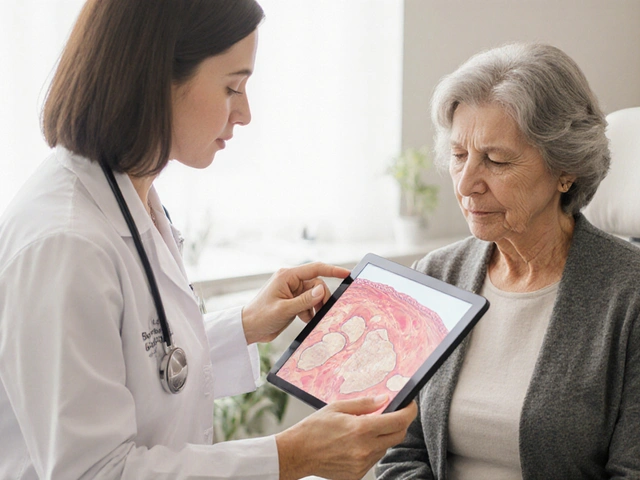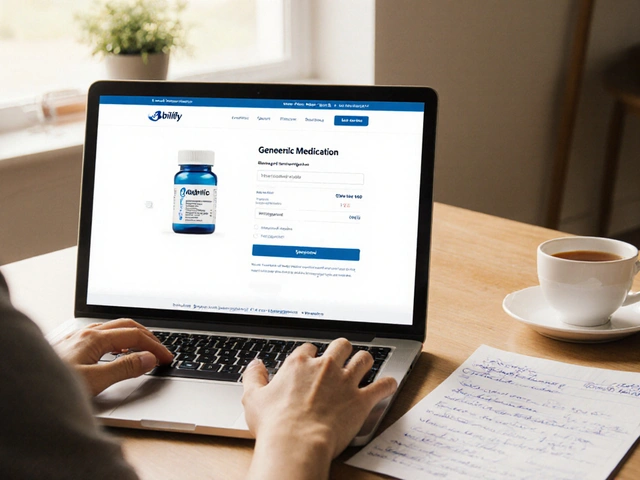Psoriasis is a chronic autoimmune skin condition that creates red, inflamed plaques and silvery scales on the skin. It affects roughly 2‑3% of the global population and often peaks during working years, making workplace‑related coping skills essential.
- Identify personal triggers and keep a flare‑up diary.
- Communicate discreetly with supervisors about needed accommodations.
- Adopt stress‑management habits that fit a busy schedule.
- Choose work‑friendly clothing and skin‑care products.
- Leverage occupational health and employee‑assistance resources.
Understanding the Stress‑Psoriasis Link
Stress acts as a powerful trigger factor for psoriasis flare‑ups. When cortisol spikes, the immune system overreacts, increasing skin inflammation. A 2023 study from the British Dermatology Society found that workers reporting high job strain experienced 30% more severe episodes than those with low stress levels.
Managing stress isn’t just about feeling better-it directly reduces the physiological drivers of skin lesions. Below are three workplace‑specific stressors and quick fixes:
- Tight deadlines: Break tasks into 25‑minute Pomodoro blocks, then step away for a short stretch.
- Open‑plan offices: Use noise‑cancelling headphones or a privacy screen to lower sensory overload.
- Client‑facing pressure: Prepare a brief “health note” for your manager so they can step in if symptoms flare unexpectedly.
Legal & Practical Workplace Accommodations
In the UK, the Equality Act 2010 protects employees with chronic health conditions, including psoriasis. Reasonable adjustments might involve:
- Flexible start/end times to accommodate morning skin‑care routines.
- Permission to keep a small cooler for moisturisers or refrigerated biologic injections.
- Access to a private hygienic space for applying topical treatments.
Talk to your occupational health representative early. Provide a concise doctor’s note outlining needed adjustments; most employers will comply without a lengthy review.
Skin‑Care Strategies That Fit a Busy Day
Consistent skin‑care is the backbone of comfort. Choose products that are fast‑absorbing, non‑greasy, and office‑friendly.
Two categories dominate:
- Moisturiser - lightweight ointments with ceramides or hyaluronic acid; apply after hand‑washing and before meetings.
- Topical therapy - corticosteroid creams for acute plaques or vitamin D analogues for long‑term control.
Both should be stored in a discreet, labeled container that fits in a desk drawer.
Medication Options and Their Workplace Impact
When topical care isn’t enough, many turn to systemic treatments. Understanding the pros and cons helps you pick a regimen that won’t disrupt work.
| Treatment | Mechanism | Onset of Relief | Typical Cost (UK) | Workplace Suitability |
|---|---|---|---|---|
| Topical steroids | Anti‑inflammatory | Days‑to‑weeks | £5‑£15 per tube | High - easy to apply discreetly |
| Vitamin D analogues | d>Immune modulationWeeks | £20‑£40 per pack | High - requires regular application | |
| Biologic therapy | Targeted immune blockade | Weeks‑months | £400‑£1,200 per month | Moderate - injection schedule may need time off |
| Oral systemic (e.g., methotrexate) | Broad immune suppression | Weeks | £10‑£30 per month | Low - regular blood monitoring required |
Biologics offer the fastest skin‑clearance for severe cases, but they often require quarterly clinic visits. If you can’t take regular days off, discuss home‑administered subcutaneous options with your dermatologist.

Clothing & Environment Choices that Reduce Irritation
What you wear can either soothe or aggravate lesions. Aim for breathable, non‑scratchy fabrics:
- Cotton - soft, natural, low‑static, ideal for shirts and under‑layers.
- Modal - a semi‑synthetic that drapes well and wicks moisture.
- Avoid wool, polyester blends, and tight elastic bands that can rub against plaques.
Office temperature plays a role, too. A study by the University of Edinburgh (2022) showed that maintaining a room temperature of 21‑23°C reduced itching episodes by 12% compared with colder settings.
When you can’t control the thermostat, keep a lightweight cardigan or office‑friendly shawl handy to cover exposed skin without overheating.
Leveraging Employee Assistance Programs (EAP) and Mental‑Health Resources
Many companies offer an Employee Assistance Program that includes confidential counseling, stress‑reduction workshops, and sometimes direct access to dermatology specialists. Use these services to:
- Develop coping scripts for discussing flare‑ups with managers.
- Join peer support groups where you can exchange practical tips.
- Access mindfulness or CBT sessions proven to lower cortisol.
Remember, mental‑health care is part of the overall psoriasis management plan-addressing anxiety can cut down on skin inflammation.
Day‑to‑Day Routine Blueprint
Putting the advice into a repeatable schedule helps you stay on track. Below is a sample 8‑hour workday routine that balances productivity with skin‑care.
- 08:30 - Arrival: Apply a fragrance‑free moisturiser to hands and any visible plaques.
- 10:00 - Break: Perform a 5‑minute breathing exercise; sip water to keep skin hydrated from within.
- 12:00 - Lunch: If using a biologic, schedule the injection in a private restroom; follow with a short walk to reduce stress.
- 15:00 - Mid‑afternoon: Re‑apply moisturiser after hand‑washing; change into a breathable shirt if you’ve been in a hot meeting room.
- 17:30 - End of Day: Quick skin check; note any new itching or redness in your diary for tomorrow’s doctor review.
Adjust times to match your shift; the key is consistency.
When to Seek Professional Help
Even with excellent self‑management, some signs indicate you need a dermatologist’s input:
- Rapid spread of plaques covering >30% of body surface.
- Severe pain, bleeding, or infection of lesions.
- Joint pain suggesting psoriatic arthritis.
Early intervention can prevent long‑term scarring and keep you productive.

Frequently Asked Questions
Can I wear a uniform if my job requires it?
Yes, but ask your employer for a fabric exception. Cotton or moisture‑wicking blends are usually acceptable, and you can request a short‑sleeve version to keep affected areas covered without extra heat.
How often should I apply moisturiser at work?
Ideally after each hand‑wash and before any meeting that lasts longer than 30 minutes. A quick dab takes less than 10 seconds and can stave off dryness.
Are biologic injections safe to store at my desk?
Most biologics are stable at room temperature for up to 14 days. Keep them in a small insulated pouch away from direct sunlight. If you’re unsure, check the product’s storage guidelines or ask your pharmacist.
What if my manager doubts my need for accommodations?
Reference the Equality Act 2010 and provide a concise medical note. If the issue persists, involve your occupational health department or a trade union representative.
Can stress‑relief apps actually help my psoriasis?
Yes. Controlled trials using mindfulness‑based stress reduction (MBSR) reported a 15‑20% reduction in PASI scores (a psoriasis severity index) after 8 weeks. Choose apps with guided breathing, short meditations, or progressive muscle relaxation.








David Lance Saxon Jr.
September 25, 2025 AT 17:00When the epidermal frontier feels like a battlefield, the office becomes the unwilling general. The cascade of cytokines mirrors a corporate hierarchy gone rogue, and cortisol acts as the overbearing manager. Identifying personal triggers is akin to mapping the supply chain of inflammation, a prerequisite for any operational overhaul. A pragmatic remedy: segment tasks into Pomodoro intervals, allowing the autonomic nervous system brief respites. In the long run, this micro‑management of stress can recalibrate the immune‑dermal axis and restore equilibrium.
Moore Lauren
September 26, 2025 AT 15:14Keep your moisturizer handy and your stress low.
Jonathan Seanston
September 27, 2025 AT 13:27Totally get that stress can feel like a sneaky coworker stealing your skin’s peace. I’ve found that a quick stretch between Zoom calls does wonders. It’s a friendly reminder that your body needs a coffee break too.
Sally Murray
September 28, 2025 AT 11:40The interplay between occupational pressure and autoimmune flare‑ups is a nuanced subject. By integrating discreet accommodations, employees can uphold both productivity and personal dignity. A flexible start time, for instance, permits a calm morning skin‑care ritual, which can mitigate morning cortisol spikes. Moreover, employing noise‑cancelling headphones can lower sensory overload, a known aggravator of plaque inflammation. Such adjustments reflect a mature organizational culture that values holistic well‑being.
Bridgett Hart
September 29, 2025 AT 09:54Honestly, the post sounds like a checklist for the privileged. Most workers can’t afford extra moisturiser or a private space for injections. The advice assumes you have the luxury of negotiating with a sympathetic manager, which is rarely the case. It’s a thinly veiled reminder that the system favors those who can already afford care.
Sean Lee
September 30, 2025 AT 08:07From a pathophysiological standpoint, the stress‑induced activation of the hypothalamic‑pituitary‑adrenal axis serves as a catalyst for keratinocyte hyperproliferation. Consequently, interventional strategies should target both psychosocial and immunological vectors. Integrating mindfulness‑based stress reduction (MBSR) with a regimented topical schedule can produce synergistic attenuation of PASI scores. Moreover, occupational health frameworks must incorporate biometric monitoring to fine‑tune these interventions. In essence, a multidisciplinary protocol is the gold standard for sustainable remission.
Michael Christian
October 1, 2025 AT 06:20Hey, I’ve been there – the itch hits hardest right before a big meeting. I keep a tiny tube of fragrance‑free cream in my pocket and dab it quick between hand‑washes. It takes seconds and keeps the skin from cracking up. Also, a 5‑minute walk outside during lunch does wonders for the mind‑body connection.
Steven Elliott
October 2, 2025 AT 04:34Oh sure, because “flexible start times” solve everything, right? Meanwhile, the real issue – the relentless email avalanche – remains untouched. Maybe we should just stop caring about skin and focus on the inbox.
Lawrence D. Law
October 3, 2025 AT 02:47It is imperative, therefore, to acknowledge the syntactical precision required when delineating accommodations; the use of “may” versus “must” carries substantial legal ramifications. Furthermore, one must consider the phonological consistency of terms such as “ceramide‑enriched moisturiser” and “non‑greasy emollient.” The discourse would benefit from a stricter adherence to the Oxford comma, particularly in enumerated lists of therapeutic interventions. Lastly, precision in temporal markers (e.g., “08:30 – Arrival”) enhances the operational clarity of the suggested routine.
Mary K
October 4, 2025 AT 01:00Imagine a workplace where your skin’s comfort is treated like a prized project – that’s the vision we need. The Equality Act isn’t just a legal shield; it’s a springboard for cultural transformation. By championing breathable fabrics and personalized break schedules, we turn invisible struggles into visible strengths. Your colleagues will thank you when you model the habit of taking a five‑minute breathing pause. Let’s make the office a sanctuary for both minds and epidermis.
Shanmughasundhar Sengeni
October 4, 2025 AT 23:14Honestly, most of this sounds like corporate buzzword bingo. People with psoriasis can’t just “choose” to wear cotton all day when dress codes are strict.
ankush kumar
October 5, 2025 AT 21:27First of all, let me say that the entire premise of navigating psoriasis at work is a micro‑cosm of the broader societal negotiation of chronic illness, which is why we need to start from the ground up. One cannot simply assume that a "lightweight ointment" will magically solve a problem that is both physiological and psychosocial. Therefore, the first step is to establish a baseline diary-not just of flare‑ups, but of every micro‑stress trigger, whether it be a loud HVAC unit, a sudden shift in meeting cadence, or even the mental load of anticipating a manager’s reaction. Once you have that data, you can employ a stratified approach: prioritize low‑effort, high‑impact accommodations like noise‑cancelling headphones, which are inexpensive and immediate. Parallel to that, you should initiate a dialogue with occupational health, framing your request in the language of productivity gains rather than personal comfort, because companies respond better to ROI arguments. Next, consider the dermatological regimen itself: select non‑greasy, fast‑absorbing moisturisers that can be applied in under 30 seconds, and keep them in a discreet, lock‑able drawer to avoid any stigma. If you’re on systemic therapy, schedule your infusion or injection days on days you can work from home, or at least negotiate a private space-this is not a whim, it’s a medical necessity. Moreover, incorporate short, structured breaks using the Pomodoro technique; these are scientifically shown to reduce cortisol spikes, which directly correlate with flare‑ups. In addition, don’t underestimate the power of peer support groups-many companies have hidden employee resource groups that can provide both emotional backing and practical tips like the best office‑friendly clothing brands. Finally, remember that the legal framework, such as the Equality Act in the UK or the ADA in the US, provides a solid footing for any accommodations you request; citing these statutes can transform a potentially contentious conversation into a procedural compliance discussion. In sum, the roadmap is: data capture, low‑cost environmental adjustments, strategic medical scheduling, legal literacy, and community support-all woven together to create a sustainable work‑life balance for someone living with psoriasis.
Cameron White
October 6, 2025 AT 19:40They don’t tell you that the real threat is the hidden agenda of pharma companies. Those “stress‑relief apps” are just data mining tools. Keep your skin care private and stay skeptical of corporate wellness programs.
Amélie Robillard
October 7, 2025 AT 17:54Wow, such a detailed guide 🎉. Totally love the suggestion of a “health note” for managers-makes life so much easier 😅. If you can’t get a private space, just use a coffee mug as a makeshift cooler 😂. Good luck, everyone!
Fae Wings
October 8, 2025 AT 16:07Reading this feels like a warm hug for anyone dealing with flare‑ups at their desk :) The step‑by‑step routine is exactly what I needed. I’m especially grateful for the reminder to re‑apply moisturizer after every hand‑wash – it’s saved my skin on countless occasions. Thank you for the empathy and practicality 🙏.
Anupama Pasricha
October 9, 2025 AT 14:20From a mentor’s perspective, the key is to integrate jargon‑rich education with actionable steps. Emphasize the neuro‑immunological loop: stress → HPA axis activation → cytokine release → skin inflammation. Providing a concise cheat‑sheet on “quick‑apply” formulations can empower employees to self‑manage without drawing attention. Additionally, encourage the formation of a peer‑led support circle that meets monthly for experience sharing. This holistic approach ensures both knowledge transfer and emotional resilience.
Bryce Charette
October 10, 2025 AT 12:34Your comments are solid, but watch the punctuation around lists. For example, use a colon before enumerating steps, and keep consistent spacing after commas. Also, remember to use "its" versus "it's" correctly when referring to the condition. Minor edits, but they improve readability.
Christina Burkhardt
October 11, 2025 AT 10:47Great discussion! For anyone still unsure, remember that the workplace should adapt to you, not the other way around. A quick tip: keep a small, labeled spray bottle of moisturizer on your desk for instant relief. 🌟 Also, don’t hesitate to ask HR for the official policy documents – knowledge is power. Stay comfortable and keep shining!